.
CONTENTS
Introduction
References and Connections
Malacandra
as Lowell's Mars
Matching
Malacandra to Barsoom
The Races
and Culture of Malacandra
APPENDICES
Quoted descriptions
of the Zorn
Quoted Descriptions
of the Hrossa
Quoted descriptions
of the Pfifltriggi
Introduction
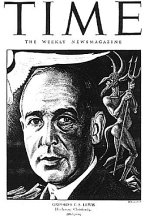 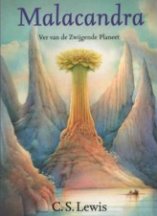 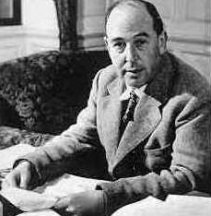
Clive Staples Lewis (1898-1963)
OUT OF THE SILENT PLANET, written in 1938, is C.S. Lewis’ tribute to
Mars, which he calls Malacandra. The plot, such as there is
of it, concerns a fellow named Ransom who is kidnapped to Mars by two villains
named Devine and Weston. These two have travelled all the way
to Mars to pan for gold. They encountered the Sorns, who wanted
them to come meet their Oyarsa. Believing the Sorns wanted a human
sacrifice, they travelled all the way back to Earth, abducted Ransom and
brought him to Mars to feed the Sorns.
Of course, Ransom runs away the first chance he gets. He
stumbles across an otter-like race, the Hrossa, who live in an immense
valley and hangs with them for a time, until he is summoned by Oyarsa.
From there, he climbs up the side of the valley meeting a Sorn named Augray,
who takes him overland to another valley called Meldidil. There,
he meets the third race of Martians, the froglike Pfifltriggi (try saying
that out loud). Elaborate descriptions of the three physical races
of Malacandra are quoted from Lewis as appendices.
He also encounters Oyarsa, who is a strange being made of light, or
a transdimensional being partly in our universe, or perhaps some sort of
psychically created guardian. Let's not make too many bones about it.
Lewis is a Christian, and Oyarsa is something like an angel or archangel
presiding over Mars.
References
and Connections
Lewis' Malacandra occasionally makes direct reference to H.G. Wells'
War
of the Worlds, both in Lewis' foreword and in Ransom's thoughts.
Ransom is terrified of meeting Wells’ Martians, one of the causes of his
panicked flight. Burroughs is never mentioned of course.
Barsoom is a bit too trashy for Lewis.
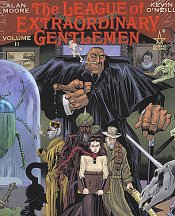 However, two
significant modern works incorporate Lewis' Malacandra and Burroughs' Barsoom
onto the same Mars, and throw in a few other references for good measure.
Alan Moore's League of Extraordinary Gentlemen, Volume II, features
Malacandra's Sorns joining John Carter's Tharks and Gulliver Jones’ Hithers
on an assault upon the Wells’ Martians. Meanwhile, Larry Niven's
Rainbow
Mars, features Sorns, Hrossa, Pfifltriggi of Malacandra, as well as
Red Men, Tharks, Kaldanes and Rykors, of Barsoom, as well as Wells' Martians. However, two
significant modern works incorporate Lewis' Malacandra and Burroughs' Barsoom
onto the same Mars, and throw in a few other references for good measure.
Alan Moore's League of Extraordinary Gentlemen, Volume II, features
Malacandra's Sorns joining John Carter's Tharks and Gulliver Jones’ Hithers
on an assault upon the Wells’ Martians. Meanwhile, Larry Niven's
Rainbow
Mars, features Sorns, Hrossa, Pfifltriggi of Malacandra, as well as
Red Men, Tharks, Kaldanes and Rykors, of Barsoom, as well as Wells' Martians.
Despite this, Lewis and his work on Mars has never really been associated
with Burroughs in the ways that Wells, Kline and Arnold were. Nevertheless,
like Wells and Burroughs, Lewis’ works live on, and arguably have more
claim to enduring status than either Kline and Arnold. Certainly,
Lewis stands well beyond the other 'Mars story' writers of the period who
are now largely forgotten.
Malacandra
as Lowell's Mars
Lewis' Malacandra is clearly Mars as Percival Lowell imagined it.
As Ransom leaves the planet, he looks out his spaceship window and describes
the scene thusly:
"The Handramit (normally river valley,
but in this case, the word refers to canals) was only a straight
purple line across the rose red surface of the harandra (the Martian highland).
The were above the junction of two handramits. One of them was doubtless
that in which he had lived, the other, that which contained Meldilorn.
The gully by which he had cut off the corner between the two was quite
invisible. Each minute more handramits came into view - long
straight lines, some parallel, some intersection, some building triangles.
The landscape became increasingly geometrical. The waste between
the purple lines appeared perfectly flat. The rosy colour of the
petrified forests accounted for its tint immediately below him; but to
the north and east the great sand deserts of which the Sorn had told him
were no appearing as illimitiable stretches of yellow and ochre.
To the west a huge discolouration began to show. It was an irregular
patch of greenish blue that looked as if it were sunk below the level of
the surrounding harandra. He concluded that it was the forest lowlands
of the Pfifltriggi - or rather one of their forest lowlands, for now similar
patches were appearing in all direction, some of them mere blobs at the
intersection of handramits, some of vast extent.... Seen from
the height which the space ship had now attained, in all their unmistakable
geometry, they put to shame his impression that they were natural valleys.
They were gigantic feats of engineering, about which he learned nothing
(168)"
So, is Malacandra also Barsoom? Or at least, can Malacandra
be found on Barsoom. Not at first glance.
Ransom's world is quite a bit different than Barsoom. The
canals, Ransom suggests to us, are actually gigantic valleys or trenches
carved into the surface thousands upon thousands of feet deep to allow
for livable air pressure and water. The upper surface of Malacandra
has air pressure roughly equivalent to the Himalayan mountains, and nothing
can live up there except the Sorns and possibly a few other species, including
a domesticated creature used for milk. According to Ransom, the canals,
featuring breathable air and marsh conditions, are occupied by Hrossa,
the sea bottoms at even lower altitudes by Pfifltriggi. Although,
thinking about it, I'm not sure why, if the sea bottoms are really the
lowest elevation, they don't ultimately drain out the canals.
Matching
Malacandra to Barsoom
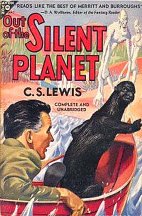 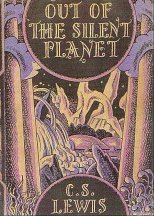 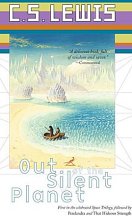 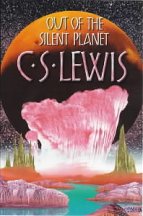
Anyway, the point is that Ransom assumes that the entire world is like
what he sees, and he generalizes his observations to the Martian landscape
he sees from space. But for once, an observer admits his limitations,
and Ransom is quite clear that his observations are tentative:
"He became vividly conscious that his
knowledge of Malacandra was minute, local, parochial. It was as if
a Sorn had journeyed forty million miles to Earth and spent his stay there
between Worthing and Brighton. (168)"
"That reminds me, the Maps of Mars which I have
consulted are so inconsistent with one another that I have given up the
attempt to identify my own handramit."
In short, he acknowledges that he has seen only a fraction of the world,
and his impressions are as limited and possibly misleading as a Sorn who
sees only a corner of England. His grasp of the planet is so
poor that he cannot even reliably compare his impressions with maps and
consistently determine where he was.
So, the door is open for us to assume that Malacandra may actually be
only a segment or region on Barsoom. But if so, where?
Ransom actually invites us to make the attempt to locate the region of
his travels, and therefore, the core of Malacandra:
"If you want to try your hand, the desideratum
is a roughly north east and south west 'canal' cutting a north and south
‘canal’ not more than twenty miles from the equator."
As described by Ransom, he believes that the highlands are uninhabitable,
at least for humans. He spends most of his time with the Hrossa in
a ‘handramit’ or valley. The description is suggestive:
"Before and behind them lay the glittering
lake, here studded with islands, and there smiling uninterruptedly at the
pale blue sky; the sun, he noticed was almost immediately overhead - they
were in the Malacandrian tropics. At each end the lake vanished into
more complicated groupings of land and water, softly, featherily, embossed
in the purple giant weed. But this marshy land or chain of archipelagos,
as he now beheld it was bordered on each side with jagged walls of the
pale green mountains, which he could hardly still call mountains, so tall
they were, so gaunt, sharp, narrow and seemingly unbalanced.
On the starboard, they were not more than a mile away and seemed divided
from the water only by a narrow strip of forest; to the left they were
far more distant, though still impressive - perhaps seven miles from the
boat. They ran on each side of the watered country as far as he could
see, both onwards and behind them. He was sailing, in fact,
on the flooded floor of a majestic canyon nearly ten miles wide and of
unknown length. . . ."
In short, Ransom is clearly describing Valles Marinis, mars 3600 mile long
canyon trench near the equator. As the journey continues, they
come to an shallow area and are forced to portage the boat. At this
point, Ransom describes a series of rapids by which the water descends
steeply for a half miles journey. The canyon then continues
at a lower level. The walls, however, do not sink at all.
Ransom concludes that the highlands are level and that the canyon has varying
depths or elevations.
In Barsoomian terms, Valles Marinis is the site of the mighty Toonolian
Marshes. However, the description we are getting, of high canyon
walls, doesn't seem to match the Toonolians at all well. Our picture
of the Toonolians is of a largely flooded canyon forming a water reservoir
supporting marshlands in a broad belt of a hundred or more miles on each
side. The canyon is flooded to the top.
However, the Toonolian marshes are only about 1800 miles in length.
They stretch only for half of Valles Marinis duration, and likely occupy
the low table lands areas of the east. Follow Valles Marinis
west, and it stretches into the Tharsis highlands.
Tharsis is an immense bulge on the side of Mars, covering about a fifth
of the planet's surface area, it is a huge region of uplift containing
most of Mars most impressive volcanoes, including Alba Patera, Olympus
Mons and the string of volcanoes known as Tharsis Montes. It is the
highest elevation of the planet being four to five kilometers above the
planetary mean, and containing even higher altitudes. So, head
that way, and you're sure to get more and more extreme cliffs, even if
the valley is wet.
Could this be the land of the Hrossa? And if so, how does
it go undiscovered on Barsoom, since the area is pretty thickly settled?
Let's take a look at those settlements though. The major
cities in the region are Toonol, Phundahl, Duhor and Kaol.
Toonol and Phundahl are at opposite ends of the Toonolian Marshes.
Toonol is at the eastern end, and thus on the wrong side. Phundahl
then holds the western side of the marshes and is the gateway to the further
reaches of Valles Marinis. Phundahl is also one of the most
regressive, isolationist, superstitious and flat out dumbest peoples on
Mars. In short, they're a pack of buffoons, and it appears
that all their interests run eastward. So they may well
be completely ignorant and oblivious to the further reaches of Valles Marinis,
and more than that, they're an obstacle to further exploration and discovery.
Which suggests that with Phundahl as a kind of big political road block,
the Hrossa could well be plausible as a lost race occupying the interior
regions of Valles Marinis. Surrounded on either side by Tharsis,
they would be extremely difficult to reach overland from north or south.
Hrossa contact with humans would only be through Phundahl, and it would
probably be rare. And the Phundahl, as beknighted and superstitious
as they are, might well consider such creatures to be demons and therefore
avoid the region.
Although Ransom never realizes it, there is evidence that the Hrossa
have had contact with Barsoomian humans. When his first Hrossa
sees him, it reacts with initial fear and flees. Clearly, it
has seen or heard tales of creatures like him. If he had been
a truly alien being, it would have reacted more with initial curiosity.
After all, Ransom looks roughly like a tiny, squat, heavy Sorn, from the
descriptions we get. The Hrossa have no fear of the Sorn.
Of the remaining Barsoomian nations, Amhor lies directly north of the
Toonolian marshes, and therefore well away from the section of territory
that we are interested in. Meanwhile, Duhor lies in the area of the
‘snow capped Artolian hills’, which would locate it on the other side of
Tharsis, in or within site of Olympus Mons and the Tharsis Montes.
This leaves only Kaol, and a problem. There is another race
on Malacandra, the frog-like Pfifltriggi. Where do they live?
"'Pfifltriggi?' said Ransom. More
than ten days journey to the west, said Hhnohra. 'The harandra (land)
sinks down not into the handramit (valley) but into a broad place, an open
place spreading every way. Five days journey from the north to the
south of it, ten days journey from the east to the west. The
forests are of other colours there than here, they are blue and green.
It is very deep there, it goes to the roots of the world.... The
Pfifltriggi live there. They delight in digging. What they
dig they soften with fire and make things of it. They are little
people, smaller than you and long in the snout, pale, busy.
They have long limbs in front. No hnau can match them in making and
shaping things as none can match us in singing.'" (78)
Okay, this doesn't seem like Valles Marinis, which for all of that is very
sharply defined canyon. It appears to be a much broader valley, an
open area, but still geographically defined. Is there any such
territory in the neighborhood? Sure there is. There's
an immense, long, but very broad valley running north/south down Tharsis
east side toward Valles Marinis.
The trouble is that we are already placing Kaol in this valley.
On the positive side, it's the site of the Kaolian forest, which matches
up well with the forested region of the Pfifltriggi. On the
other hand, this is Kaol we're talking about.
The Kaolians are far from stupid, making them quite unlike the Phundahls.
However, John Flint Roy's ‘A Guide to Barsoom’ which is an essential reference
manual describes Kaol thusly:
"Lying as it does in a natural depression,
climactic conditions are such that the entire area is heavily forested,
an unusual feature on this dying planet. Isolated and entirely self
supporting its people are deeply loyal to both state and doctrine.
There are several cities within the Kaolian forest, connected by a splendid
road network. When John Carter first visited this country, Kaol had
no aircraft and therefore no landing areas. However, since then they
have acquired a respectable armada."
So, the key words here are 'isolated', 'entirely self supporting' and 'no
aircraft.' The Pfifltriggi are probably located in the southern
region of the great valley, near the reaches where it connects to Valles
Marinis. Again, the area would be shielded from the south,
east and west by the Tharsis highlands. The most likely access
would be through the shallower northeastern side of the valley.
And in fact, this would be through an area under the control of the Kaolians.
In short, the Kaolians, like the Phundahls would amount to a barrier city,
preventing access
The Kaolians may well be aware of the Pfifltriggi and may even have
trading relations with them. On the other hand, there's no reason
that any other city state or nation on Barsoom would have any opportunity
to know of them, except through Kaol. And the Kaolians are isolationists.
There is one further observation worth making about the Pfifltriggi,
and that is that they are markedly smaller than human, frog bodied with
distorted proportions. In short, they are dwarvish beings.
Burroughs never mentions Dwarfs on Barsoom. On the other hand,
several writers do. Henri Gayer's 'Serge Myrandahl' discovers
red haired or red furred cave dwelling dwarfs in the northern region of
Tharsis, around the area we have identified as Alba Patera.
Meanwhile, Galopin records the tale of an occultist who astrally projects
to Mars and finds cave dwelling dwarfs, in a region we've also tentatively
pegged as northern Tharsis, this time around the interior of Tempe Terra.
Fictional characters Dr. Omega and Narcisse Barbidon also encounter races
of Dwarves.
The Sorns are the first race that Ransom encounters, and they are probably
the easiest to locate. The Sorns are high altitude beings, living
comfortably at elevations that Humans and Hrossa cannot tolerate.
This is why their chests are so big, huge lungs. On Barsoom
of course, humans can breath well enough at normal elevations. But
there is one region which is so elevated that the air might well become
too thin for normal activity: Tharsis.
Ransom assumes that the Zorns territory is pretty much the whole of
the surface of Mars, excluding only the lowland sea bottoms and canal canyons.
The truth is that the Sorns range is likely far narrower, the Tharsis uplift
region. But having said that, the region covers a fifth of
the entire planet, so they have plenty of territory.
And of course, the valley of the Pfiltriggi in its southern reach, as
well as the western ends of Valles Marinis where we ascribe the Hrossa,
are bordered on each of their sides by Tharsis. Which means that
there is a meeting point or region where all three races would naturally
mingle.
Before we conclude, there is a fourth race of Martians which Ransom
is told of, but which are, apparently extinct:
"'It was the old forests of Malacandra,'
said Augray, ‘Once there was air on the Harandra and it was warm....
It was then these forests grew, and in and out among their stalks,
went a people that have vanished from the world these many thousands of
years. They were covered not with fur, but with a coat like
mine. They did not go in the water swimming or on the ground
walking; they glided in the air on flat broad limbs which kept them up.
It is said they were great singers...'"
Ransom calls them birds, but note that Augray the Sorn describes them as
people. A description which implies that these creatures were
sentient and intelligent, and had language, sociability and technology.
Burroughs, of course, never describes flying Barsoomians, though his
Barsoom does contain gigantic flying birds and huge flying insects.
However, Wells’ describes winged flying Martians, as does Kline, as does
Le Rouge and Gayer. In all, there are at least ten stories of Mars
which feature flying winged humanoid beings.
And as a side note, Leigh Bracket's Sword of Rhiannon, from 1953,
depicts an archeologist named Matt Carse who travels back in time to the
Ocean period of Mars civilization, and there encounters, in addition to
human races, both a winged race of flyers and a furred otterlike race of
intelligent beings.
What evidence of the geographical range of these winged humanoid beings
that we, from Wells', Le Rouge's and other stories, have, suggests that
their range is in the southern regions of Tharsis, extending into the Toonolian
marshes in the East, and as far west as the Thakkor marshes which surround
the Elysium plateau. This means that the region of the Hrossa
and Pfifltriggi is well within the geographical range of these creatures.
They are obviously extinct in the Malacandra region, but doing fine in
other areas.
The
Races and Culture of Malacandra
The three extant races of Malacandra appear to fit loosely into the
taxonomy of humanoid Barsoomians. They are all four limbed
creatures, which suggest that they are related to the humans of Barsoom.
In fact, their body plans do not diverge strongly from that of Barsoomian
humans. The Sorn are incredibly tall and lean, but essentially human
in conformation. The Pfifltriggi are frog bodied, but then
again, humans themselves have the same rough proportions as frogs.
The Pfifltriggi are specifically mentioned to be egg layers. The
otter-like Hrossa have long torsos and short limbs. (It should
be noted that the life spans of the Malacandran races, with the possible
exception of the Sorns, are far inferior to Barsoomians. The
Hrossa life span is about 160 Earth years, the Pfifltriggi substantially
less.)
Meanwhile, on Barsoom, although most of the identified races, the Okar,
the Orovar, Thern, Red and First Born are of narrowly human appearance
and proportion, there is a couple of apparently ‘human’ race which deviates
substantially: The Kangaroo Men of the Toonolian Marshes seem
human except for a series of adaptations, like jumping legs, balancing
tails and pouches. The Rykors worn by the Kaldanes resemble
headless men. In short, these two suggest that Barsoomian humans
may have an outer range of variation in their pasts, particularly for specific
environments, that could include the Malacandran races.
There are a couple of interesting cultural overlaps between the Malacandrans
and the Barsoomians.
First, the Malacandrans like the Barsoomians, speak a single common
language. Unlike the rest of the Barsoomians, the Malacandrans
appear to retain some traces of their local languages, and there appear
to be a series of terms and terminology not found elsewhere on Barsoom.
But overall, they appear to speak a common root language.
Secondly, Malacandran lore, like Barsoomian, speaks to a relatively
rapid planetary catastrophe. When the atmosphere and oceans went,
as on Barsoom, it went fast for the Malacandrans, within a few thousands
of years.
Third, and perhaps most interesting, the funeral rites:
"I see the Malacandran sky at morning...
There are figures walking before me, slender yet gigantic forms, black
and sleek as animated tall hats... They go down singing to the edge
of the lake. The music fills the wood with its vibration, though
it is so soft that I can hardly hear it; it is like dim organ music.
Some of them embark, but most remain. It is done slowly, this is
no ordinary embarkation, but some ceremony. It is, in fact, a hross
funeral. Those three with the grey muzzle whom they have helped into
the boat are going to Meldilorn to die. For in that world, except
for some few whom the Hnakra gets, no one dies before his time. All
live out the full span allotted to their kind... And now they are
off to receive the last counsel of Oyarsa, to die and to be by him ‘unbodied’.
The corpses, as corpses, will exist only for a few moments. There
are no coffins in Malacandra, no sextons, churchyards or undertakers.
The valley is solemn at their departure,, but I see no signs of passionate
grief. They do not doubt their immortality, and friends of the same
generation are not torn apart. Death is not preceded by dread
nor followed by corruption."
In short, like Gulliver Jones Hither and Thither people, and their final
journey on their River of Death to the northern ice, and like the Barsoomians
of other regions, and their final journeys on the River Iss, the Malacandra
people, when they are dead or ready to die travel by boat up their canals
or rivers to their source, the valley of Meldilorn, for their passage to
the next life.
We note that Oyarsa is apparently able to reach out and communicate
throughout his region. Oyarsa speaks twice to Ransom and such visitations
are not considered unusual. Oyarsa also claims to have jurisdiction
over all of Malacandra. The need to go on the final journey,
so similar to the traditions of Barsoomians and Hither, seems to be a common
cultural linking figure. The destinations of the river are
different, but the journey down the river towards the gateway to the other
world is common to all three.
It's also notable that Oyarsa appears to oversee every ‘funeral’ personally.
All dead and dying make the journey to Meldilorn. This seems
to imply that Malacandra is actually a relatively small corner of Barsoom.
Imagine transporting every corpse from every corner of Mars for the entire
population of the planet? Meldilorn would be a non-stop funeral assembly
line. (Though arguably, perhaps Meldilorn is just the regional
funeral/holy place, and Oyarsa simultaneously supervises dozens upon dozens
of other sites).
There are anomalies. Barsoom is a warlike place, but the
races of Malacandra are decidedly not warlike. But that may be a
factor of their isolation, and the fact that their areas are inaccessible
to much of the planet and guarded by relatively xenophobic Barsoomian city
states. The largest anomaly, of course, is Oyarsa itself,
a benign, semi-divine, non-material entity which seems to protect the Malacandrans.
Ransom seems to place this creature as an agent of god in a pseudo-Christian
philosophy. What Oyarsa is and how it relates to the beings
of Barsoom is a mystery I do not feel the need to answer.
It may be exactly what Ransom believes it to be, it may be some sort of
benign transdimensional being, it may be a manifestation of the collective
psychic will of the Malacandrans (perhaps similar to the psychic constructs
of Lothair). It is sufficient that Oyarsa appears to confine
its reach to the borders of Malacandra within Barsoom.
Ultimately then, it seems more than possible to fit Malacandra into
Mars, alongside Burroughs Barsoom, Kline’s and Wells’ Mars, and the peoples
and races and geography of other Mars. In short, it's all Barsoom,
wall to wall.
APPENDICES
Quoted descriptions of the
Zorn (the numbers are page references from the Pan Books, 1977 printing)
Long streaky white reflections motionless
in the running water.... He looked up. Six white things were
standing there. Spindly and flimsy things, twice or three times the
height of a man. His first idea was that they were the images of
Men, the work of savage artists. He had seen things like them in
books of archeology. But what could they be made of and how could
they stand? So crazily thin and elongated in the leg, so top-heavily
pouted in the chest, such stalky, flexible-looking distortion of earthly
bipeds... Like something seen in one of those comic mirrors.
They were certainly not made of stone or metal, for now they seemed to
sway a little as he watched; now with a shock that chased the blood from
his cheeks he saw that they were alive, they were coming at him.
He had a momentary, scared glimpse of their faces, thin and unnaturally
long, with long drooping noses and drooping mouths of half spectral, half
idiotic solemnity. (50) One of the things sent its voice
across the water to them; an enormous horn like voice far above their heads...
Suddenly, a second, much louder and less articulate noise broke from he
creatures on the far bank. (51) The giant stature, the
cadaverous leanness, the long drooping wizard like profile....
The head appeared to be narrow and conical. The hands.... were
thin, mobile, spidery and almost transparent. (60) It
was sitting on its long wedge shaped buttocks with its feet drawn up close
to it. A man in the same posure would have rested his chin
on his knees. But the Sorn's legs were too long for that. It's
knees rose high above its shoulders on each side of its head - grotesquely
suggestive of huge ears - and the head down between them, rested its chin
on the protruding breasts. The creatures seemed to have either
a double chin or a beard; Ransom could not make out which in the firelight.
It was mainly white or cream in colour and seemed to be clothed down to
the ankles in some soft substance that reflected the light. On the
long fragile shanks, where the creature was closest to him, he saw that
this was some natural kind of coat. It was not like fur, but
more like feathers. In fact, it was almost exactly like feathers.
The whole animal, seen at close quarters, was less terrifying than he expected,
and even a little smaller. The face, it was true, took a good
deal of getting used to - it was too long, too solemn, too colourless,
and it was much more unpleasantly like a human face than any inhuman creature's
face ought to be. Its eyes, like those of all large creatures, seemed
too small for it. It was grotesque rather than horrible.
(106) Ransom could not restrain a shudder at the touch of the
Sorn’s hands upon his body; they were fan-shaped, seven fingered, mere
skin over bone like a bird's leg, and quite cold. (113)
Its gait was perhaps the least human thing about it. It lifted
its feet very high and set them down very gently. Ransom was reminded
alternately of a cat stalking, a strutting ban door fowl, and a high stepping
carriage horse; but the movement was not really like that of any terrestrial
animal. ... They seemed to be doing between six and seven miles an
hour. (114) They passed many caves where Sorns
lived.... Sometimes a high cliff would be perforated with countless
holes, all the way to the top and unidentifiable noises came from within.
Nowhere did he see anything like a village or city of Sorns.
Who were apparently solitary not social creatures. (116)
The seemed to be skating rather than walking. The lightness of their
world and the perfect poise of their bodies allowed them to lean
forward at right angles to the slope. (117) There is also at
least one other kind of Sorn besides the kind I saw - the Soroborn or red
Sorn of the desert, who lives in the sandy north. He's a corker by
all accounts. (182)
Quoted Descriptions of the
Hrossa
The Hrossa are an otterlike species.
Six or seven feet high, two thin for its height. It had a coat
of thick black hair, lucid as sealskin, very short legs with webbed feet,
a broad beaver like or fish like tail. Strong forelimbs with
webbed claws or fingers. It was something like a penguin, something
like an otter, something like a seal. The slenderness and flexibility
of the body suggested a giant stoat The great round head, heavily
whiskered, was mainly responsible for the suggestion of a seal. But
it was higher in the forehead than a seal's and the mouth was smaller.
(61) He had a vague notion that the jaws and mouth of
the beast were not those of a carnivore. (62) A man seven
feet high, with a snaky body, covered, face and all with thick black animal
hair and whiskered like a cat. But starting from the other
end, you had an animal with everything an animal ought to have - glossy
coat, liquid eyes and whitest teeth - the charm of speech and reason.
(66) The normal body temperature of a Hross is 103 degrees.
I know, though I can't remember learning it, that they live ... About
160 earth years. That they marry at about 40. That they don't
shed tears or blink. (181) My friends were black
Hrossa, but there were also silver hrossa and in some of the western handramits
one finds the great crested Hross - ten feet high, a dancer rather than
a singer, and the noblest animal after man, that I have ever seen.
Only the males have a crest. I also saw a pure white Hross at Meldilorn,
but like a fool, I never found out whether he represented a sub-species
or was a mere freak like our terrestrial albino. (182)
Quoted descriptions of the
Pfifltriggi
‘Pfifltriggi?’ said Ransom. More
than ten days journey to the west, said Hhnohra. ‘The harandra (land)
sinks down not into the handramit (valley) but into a broad place, an open
place spreading every way. Five days journey from the north to the
south of it, ten days journey from the east to the west. The
forests are of other colours there than here, they are blue and green.
It is very deep there, it goes to the roots of the world.... The
Pfifltriggi live there. They delight in digging. What they
dig they soften with fire and make things of it. They are little
people, smaller than you and long in the snout, pale, busy.
They have long limbs in front. No hnau can match them in making and
shaping things as none can match us in singing. (78)
He saw pictures of Hrossa and smaller frog like animals. The frog
like animals, or frog-bodied Tapir headed animals were Pfilfltriggi.
(79) A remarkable face appeared... It was hairless
like a man's or a sorn's. It was long and pointed like a shrew's,
yellow and shabby looking and so low in the forehead that but for the heavy
development of the head at the back and behind the ears (like a bag wig)
it could not have been that of an intelligent creature. A moment
later he whole of the thing came into view with a startling jump.
It was much more insect like or reptilian than anything he had yet seen.
It's build was distinctly that of a frog, and at first, Random thought
it was resting, frog-like on its ‘hands’. Then he noticed that that
part of its fore limbs on which it was supported was really, in human terms,
rather an elbow than a hand. It was broad and padded and clearly
made to be walked on; but upwards from it, at an angle of about forty-five
degrees, went the true forearms - thin strong forearms, ending in enormous,
sensitive, many fingered hands. He realized that for all manual work
from mining to cutting cameos, this creature had the advantage of being
able to work from its full strength from a supported elbow.
The insect like effect was due to the speed and jerkiness of its movements
and the fact that it could swivel its head almost all the way around like
a mantis; and it was increased by a kind of dry, rasping, jingling quality
in the noise of its moving. It was rather like a grasshopper, rather
like one of Arthur Rackham's dwarfs, rather like a frog, and rather like
a little old taxidermist whom ransom knew in London. (130-131)
He saw that the jingling and metallic noise was due to the number of small
instruments which it carried about its body. Sometimes with an air
of annoyance, it would throw down the tool it was working with and select
one of these; but the majority of those in immediate use it kept in its
mouth. (131-132) I never saw the Pfilfltriggi at home.
But if you can work it in, there is no harm in explaining that they are
oviparous and matriarchal and short lived compared with the other species.
(183)
|
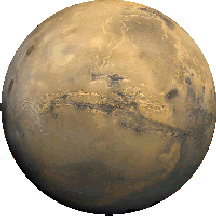 . . .. . .
. . .. . . 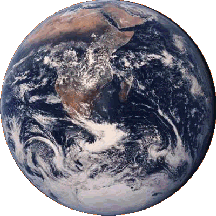

![]()

![]()